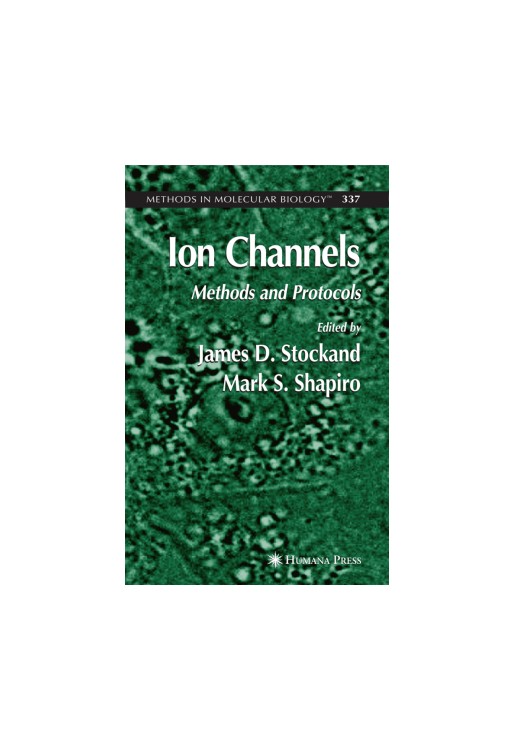The diverse applications in this volume range from the study of allosteric regulation of ion channel activity using a classic mutagenesis approach, to the study of channel subunit stoichiometry using a novel biophysical approach based on fluorescence resonance energy transfer. Highlights include methods for heterologous expression of ion channels in cells, for determining channel structure-function, and for studying channel regulation. It is now clear that ion channels play essential roles in cell biology and physiology and that their dysfunction is the root cause of many human diseases. In Ion Channels: Methods and Protocols, internationally recognized biomedical scientists describe recent technological breakthroughs and demonstrate their use in successful experimental designs. The diverse applications range from the study of allosteric regulation of ion channel activity using a classic mutagenesis approach, to the study of channel subunit stoichiometry using a novel biophysical approach based on fluorescence resonance energy transfer. Highlights include methods for heterologous expression of ion channels in cells, for determining channel structure-function, for studying channel regulation and physiological function, and for genetic screening and investigating channelopathies. The protocols follow the successful Methods in Molecular Biology series format, each offering step-by-step laboratory instructions, an introduction outlining the principles behind the technique, lists of the necessary equipment and reagents, and tips on troubleshooting and avoiding known pitfalls.
Comprehensive and highly practical, Ion Channels: Methods and Protocols offer both novice and experienced researchers a versatile collection of proven techniques for illuminating the structure, function, and regulation of ion channel proteins and finding suitable drug targets when they cause disease.
Part I. Methods for Exogenous Expression of Ion Channels in Cells
Functional Reconstitution of the Human Epithelial Na+ Channel in a Mammalian Expression System
Alexander Staruschenko, Rachell E. Booth, Oleh Pochynyuk, James D. Stockand, and Qiusheng Tong
Overexpression of Proteins in Neurons Using Replication-Deficient Virus
Richard M. Ahlquist and Jane M. Sullivan
Exogenous Expression of Proteins in Neurons Using the Biolistic Particle Delivery System
Nikita Gamper and Mark S. Shapiro
Part II. Methods for Studying Channel Structure-Function
Tertiary and Quaternary Structure Formation of Voltage-Gated Potassium Channels
John M. Robinson, Andrey Kosolapov, and Carol Deutsch
Biophysical Approach to Determine the Subunit Stoichiometry of the Epithelial Sodium Channel Using the Xenopus laevis Oocyte Expression System
Farhad Kosari, Shaohu Sheng, and Thomas R. Kleyman
Spectroscopy-Based Quantitative Fluorescence Resonance Energy Transfer Analysis
Jie Zheng
Part III. Methods for Studying Channel Regulation and Physiological Function
Probing the Effects of Phosphoinositides on Ion Channels
Chou-Long Huang
Epithelial Sodium Channel in Planar Lipid Bilayers
Bakhrom K. Berdiev and Dale J. Benos
A Simple In Vivo Method for Assessing Changes of Membrane- Bound Ion Channel Density in Xenopus Oocytes
Mouhamed S. Awayda, Weijian Shao, Ivana Vukojicic, and Abderrahmane Bengrine
Preparation of Cortical Brain Slices for Electrophysiological Recording
Costa M. Colbert
Juxtacellular Labeling and Chemical Phenotyping of Extracellularly Recorded Neurons In Vivo
Glenn M. Toney and Lynette C. Daws
Carbon Fiber Amperometry in the Study of Ion Channels and Secretion
Duk-Su Koh
Part IV. Methods for Studying Channelopathies, Genetic Screening, and Molecular Biology
Genetic Screening for Functionality of Bacterial Potassium Channel Mutants Using K+ Uptake-Deficient Escherichia coli
Lyubov V. Parfenova and Brad S. Rothberg
KCNQ1 K+ Channel-Mediated Cardiac Channelopathies
Gildas Loussouarn, Isabelle Baró, and Denis Escande
Tissue-Specific Transgenic and Knockout Mice
Andrée Porret, Anne-Marie Mérillat, Sabrina Guichard, Friedrich Beermann, and Edith Hummler
Index


